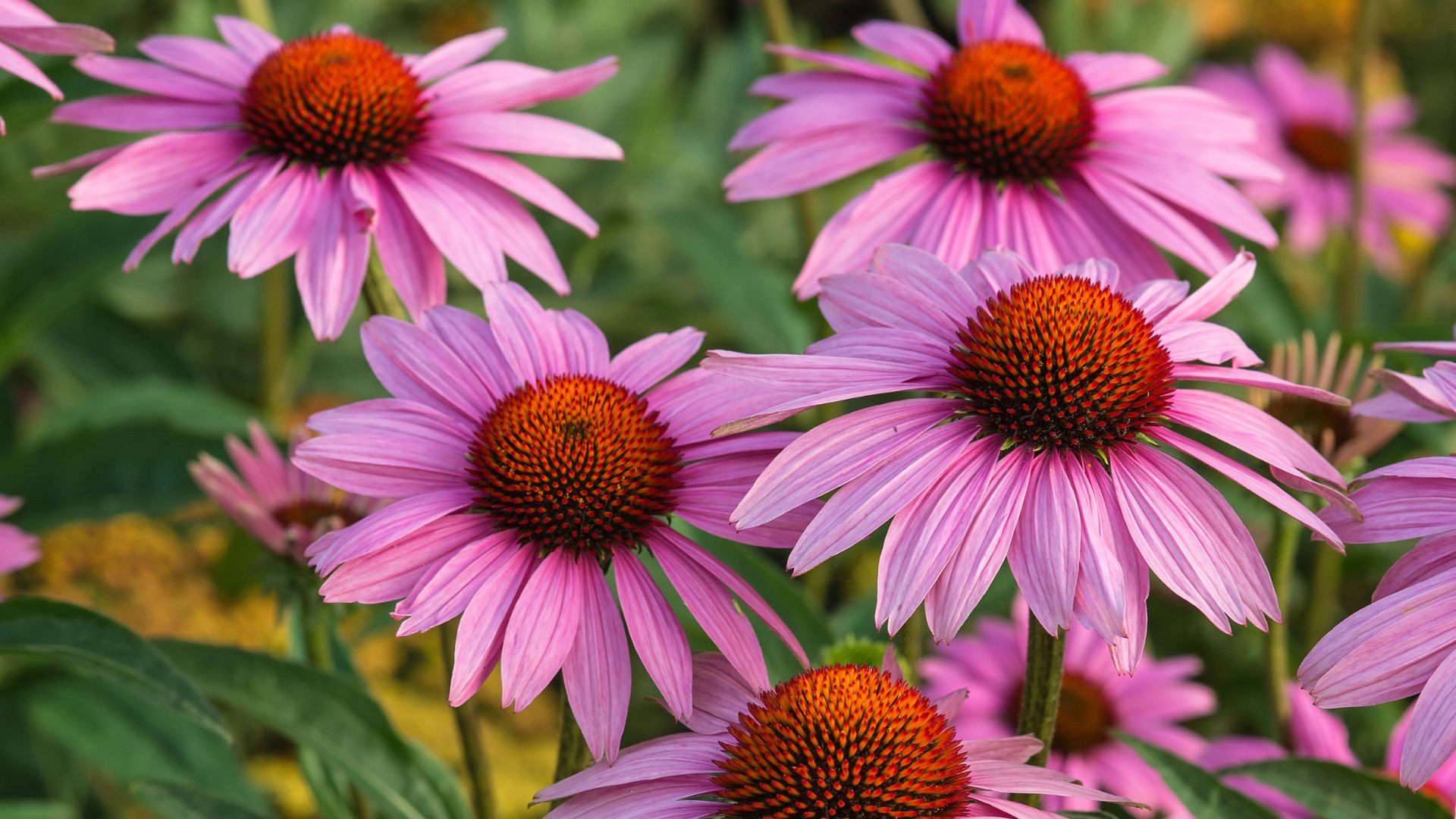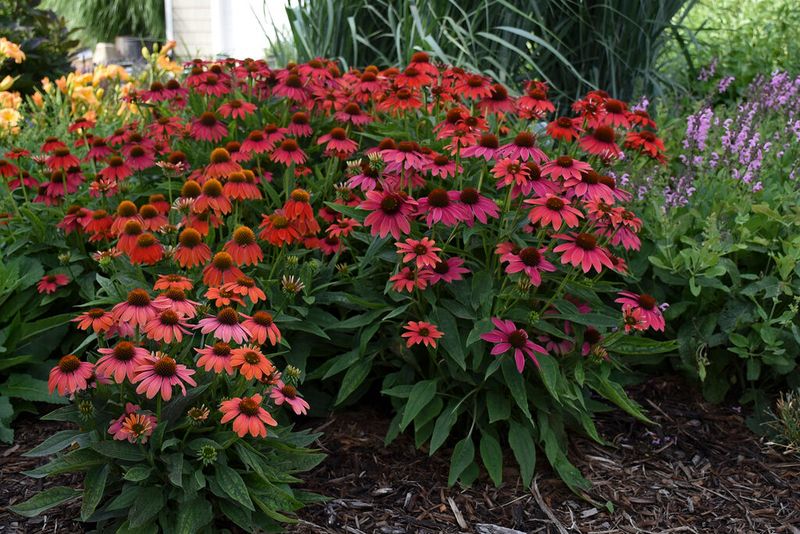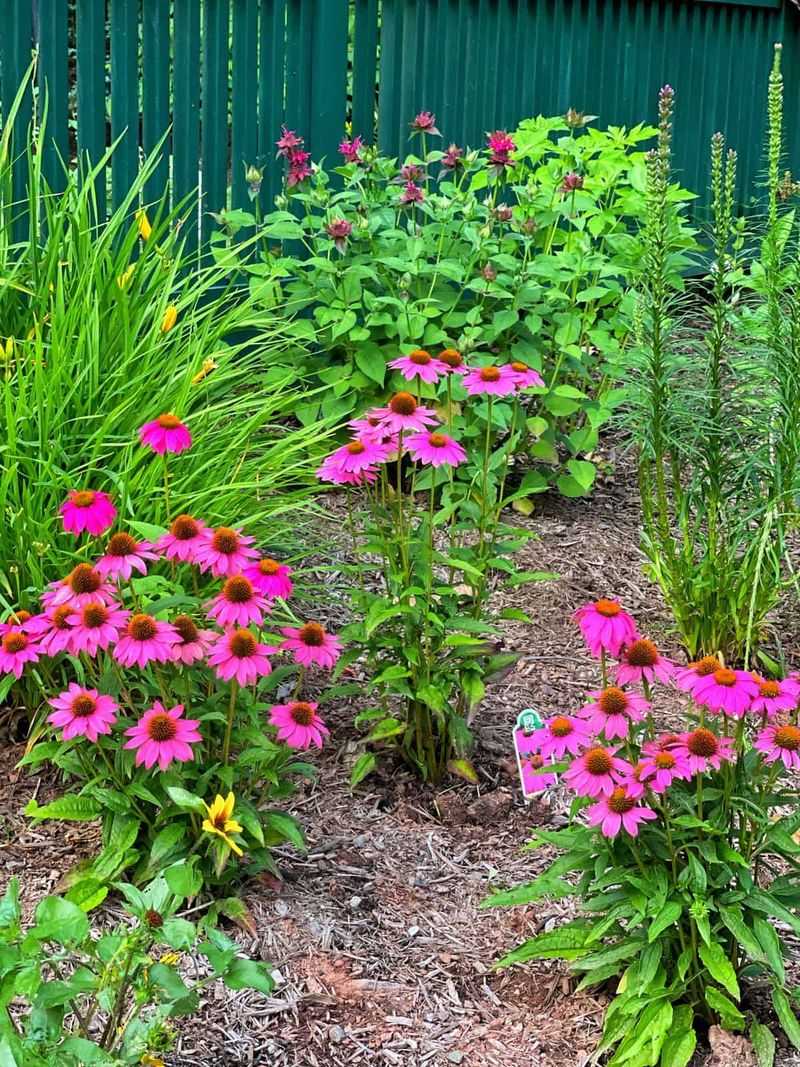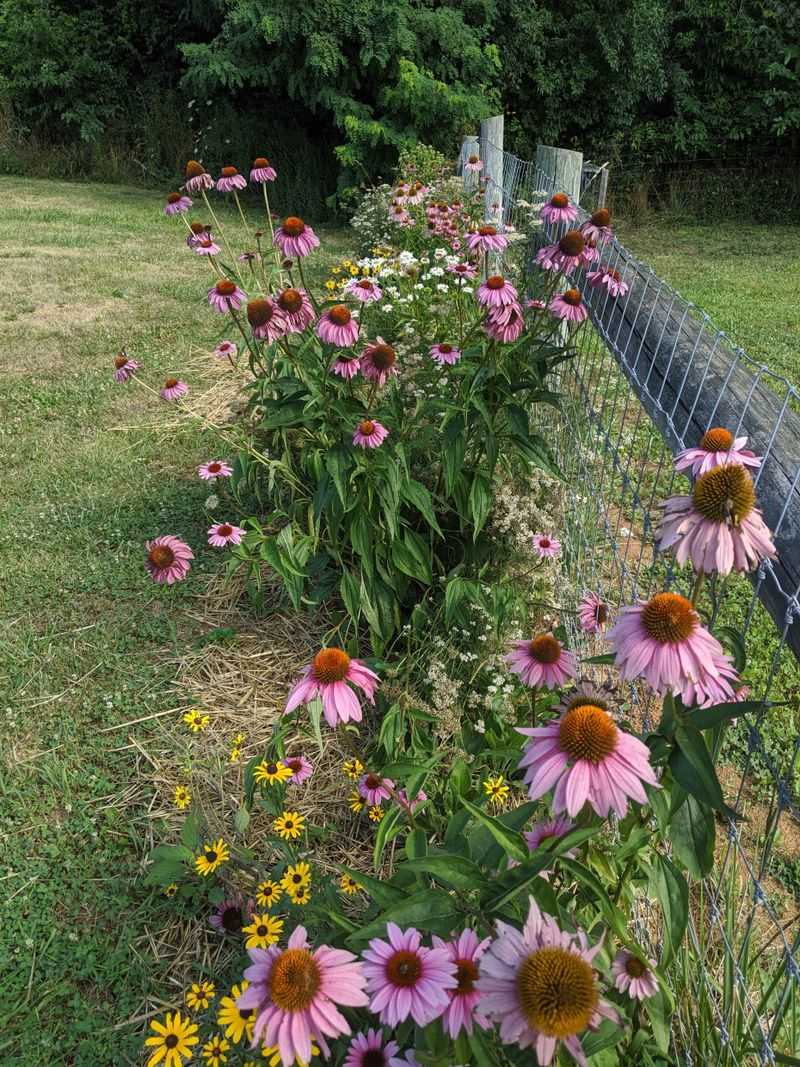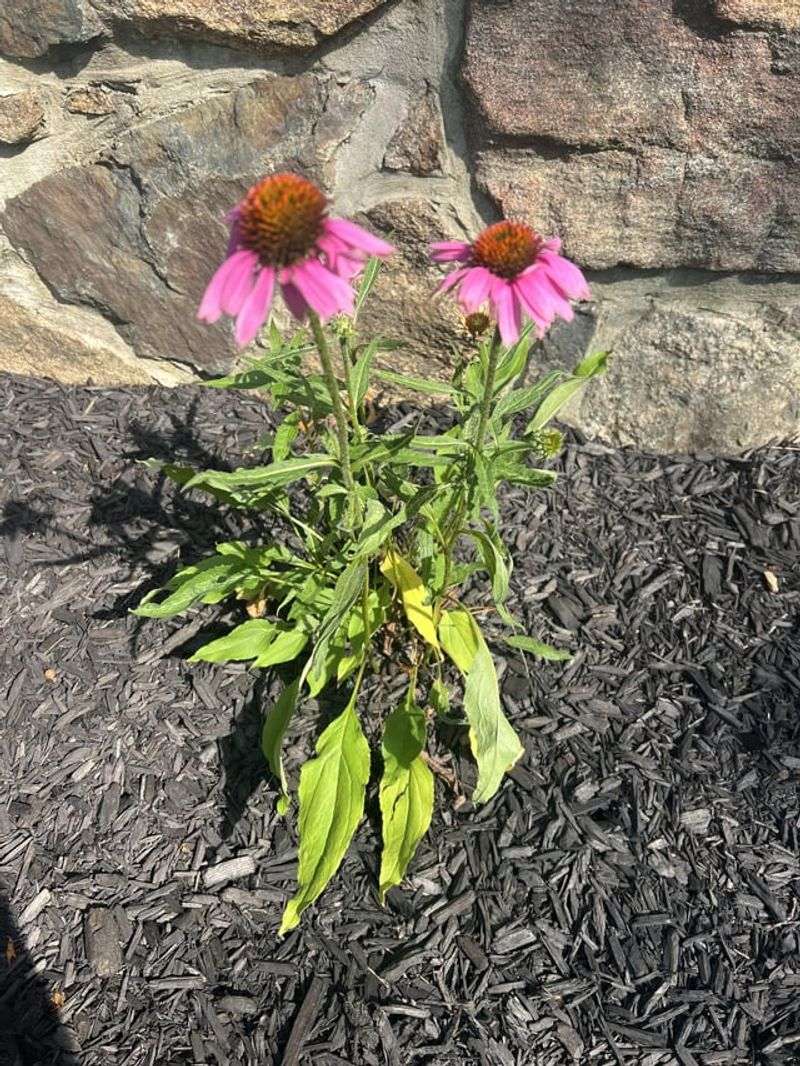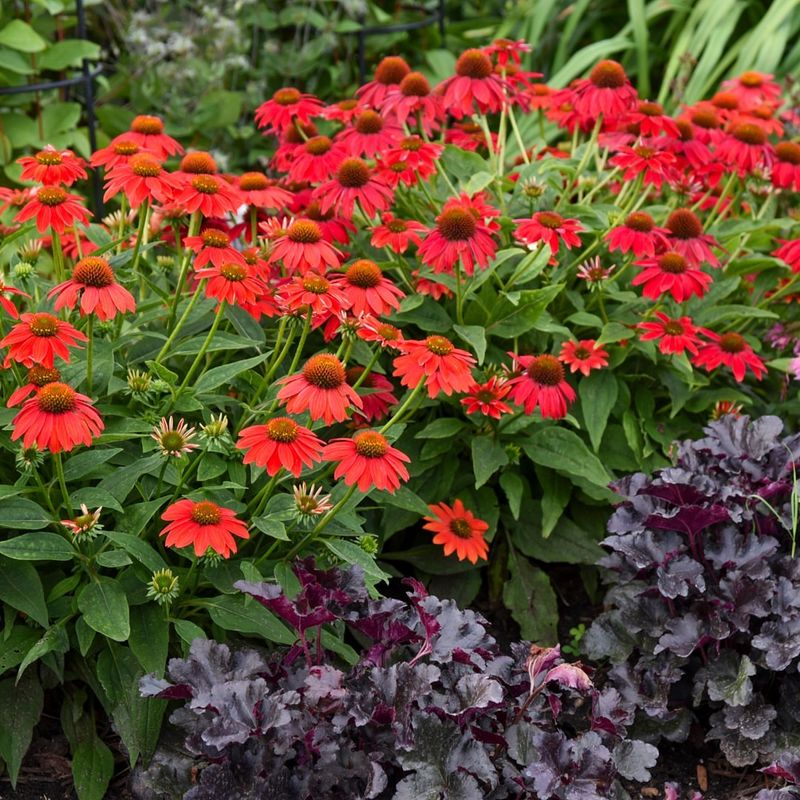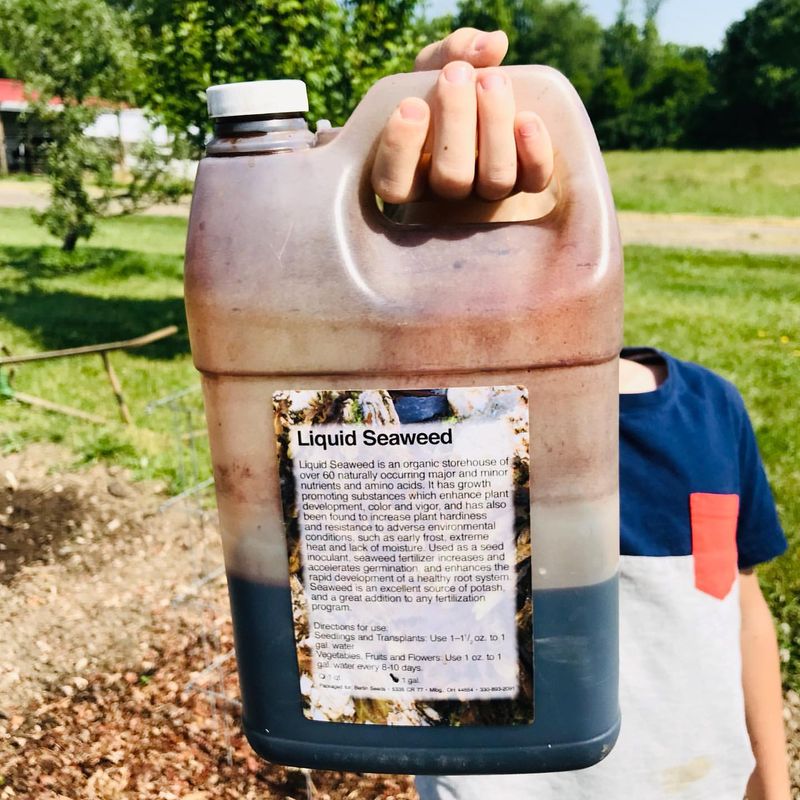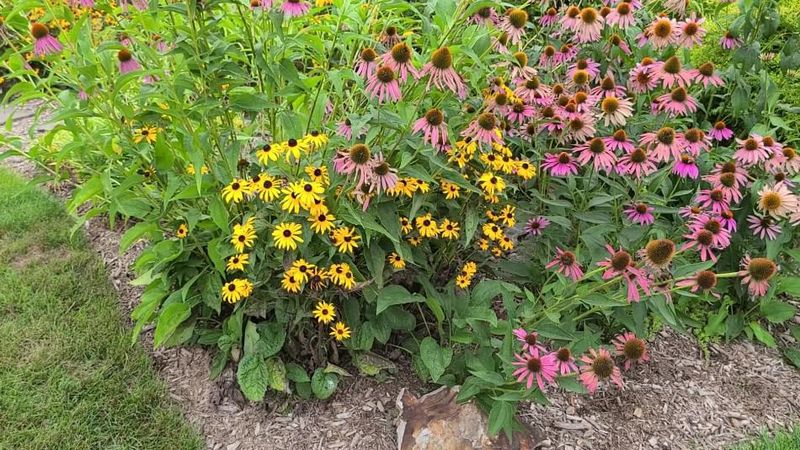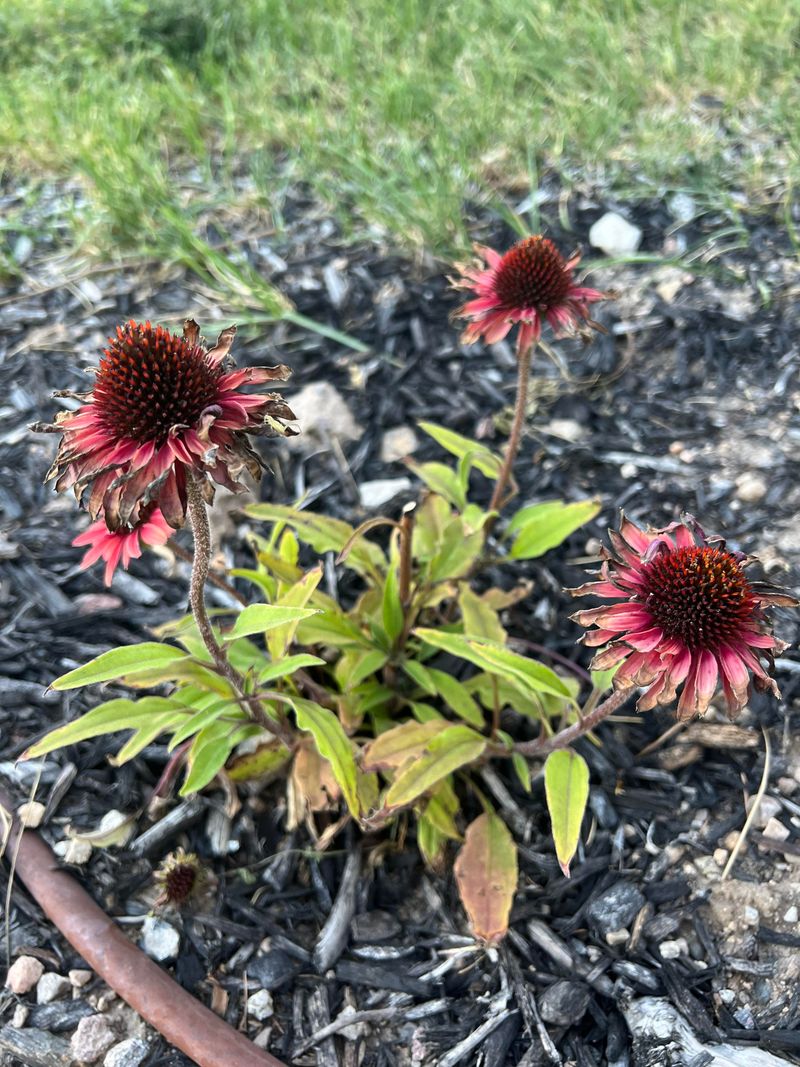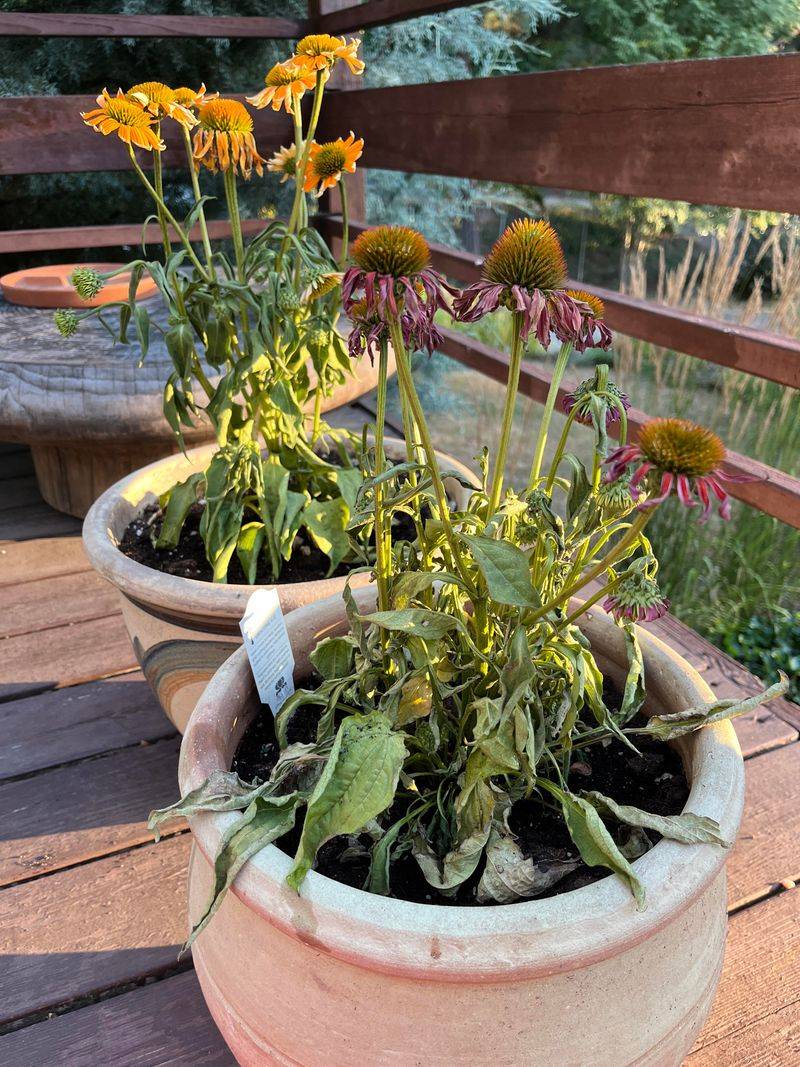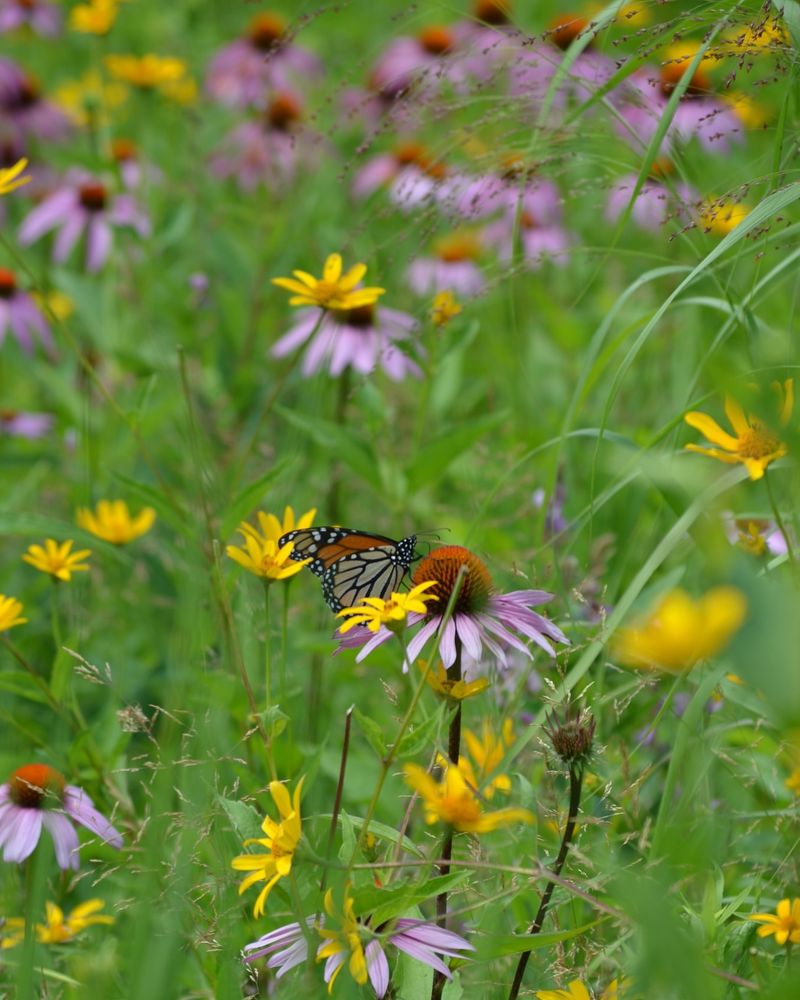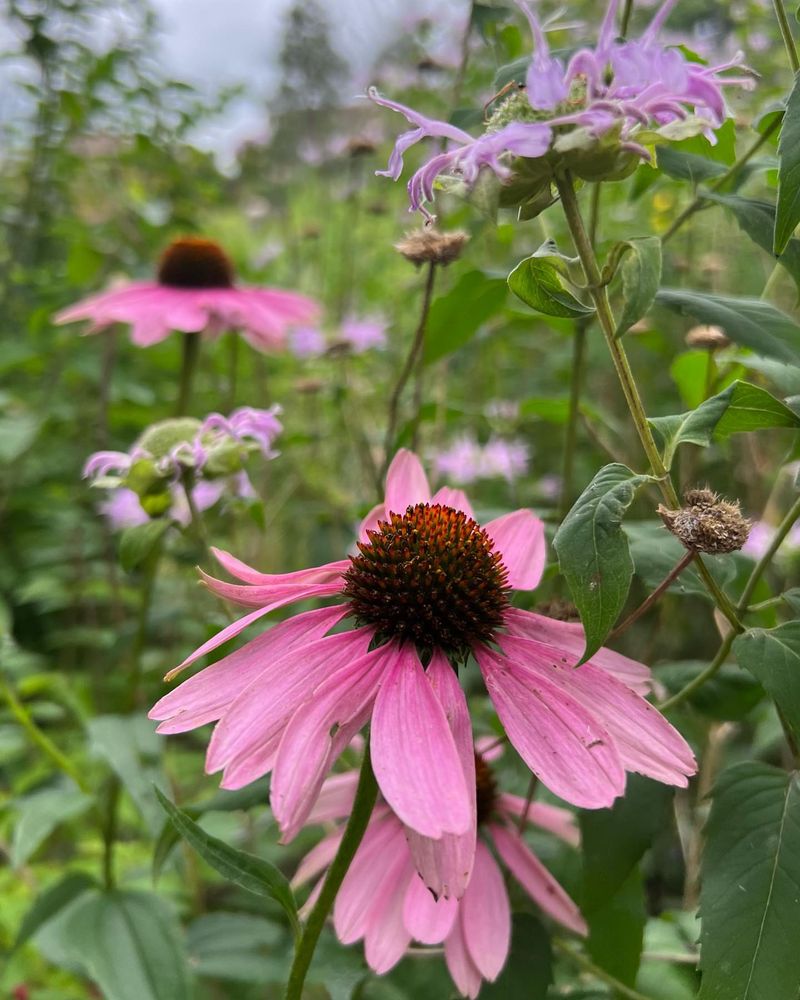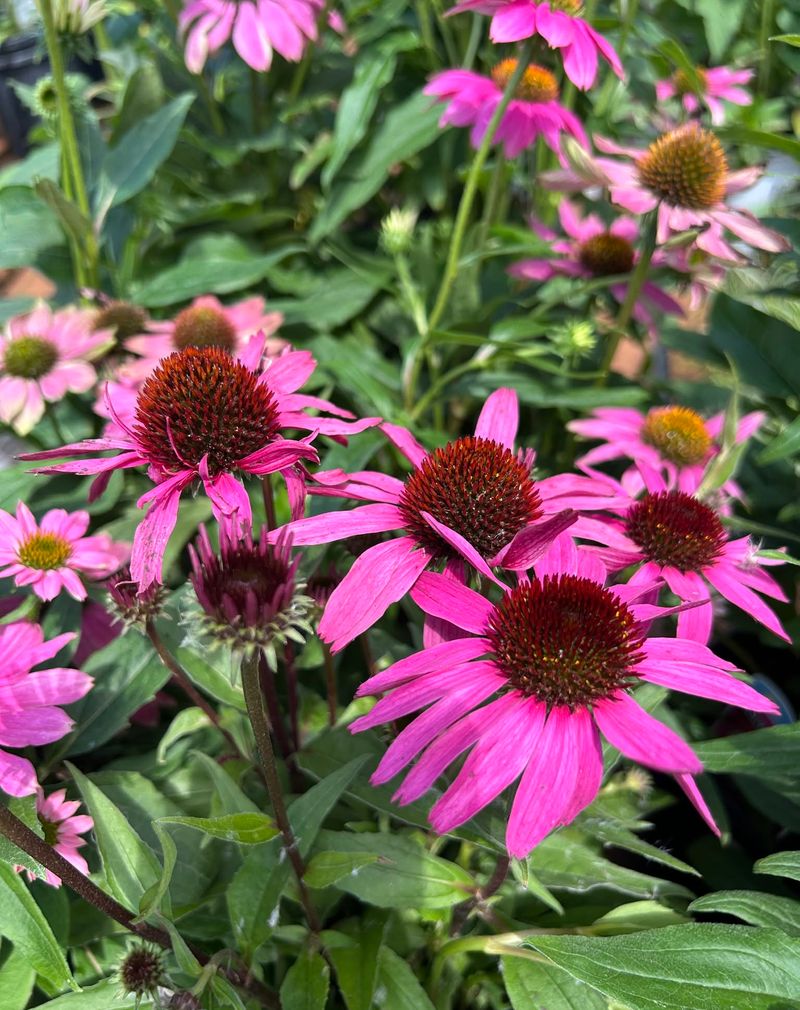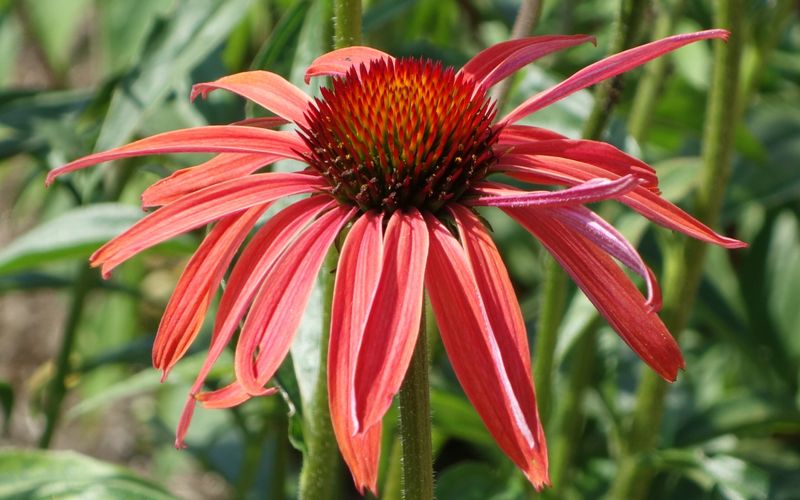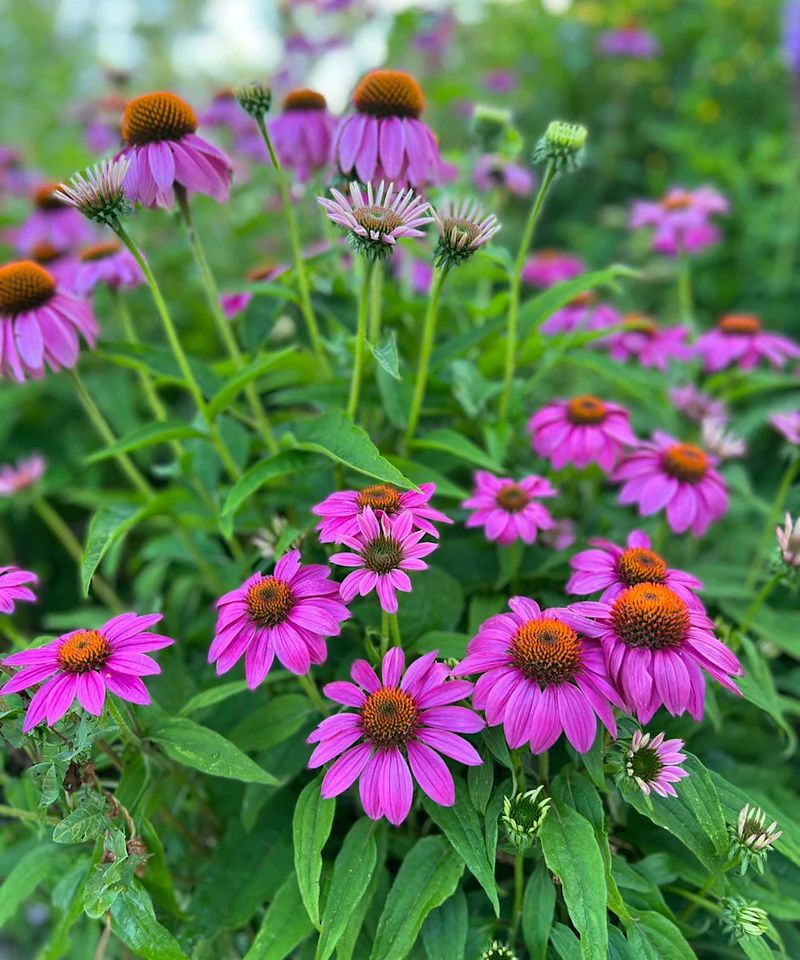Just when your coneflowers should be stealing the spotlight, summer heatwaves can leave them drooping or flowerless. Echinacea might be prairie tough, but even these resilient blooms have their limits when temperatures soar.
Dry soil and intense sun are common stress triggers, especially if the plants aren’t well-established. Deep, infrequent watering helps roots grow strong and stay cool. Adding mulch keeps moisture in and shields roots from scorching heat.
To keep the flowers coming, deadhead spent blooms and trim any leggy growth. With a little smart care, your coneflowers can power through July’s sizzle and keep your garden looking stunning all season long.
1. Morning Watering Ritual
Timing makes all the difference when hydrating coneflowers during heatwaves. I’ve found that a deep soak before 8 AM allows roots to absorb moisture before the day heats up.
Water at soil level rather than overhead to prevent fungal issues that heat and humidity can trigger. The leaves stay dry while roots get what they need.
One thorough watering beats several light sprinkles, encouraging deeper root growth that helps plants withstand afternoon heat stress.
2. Strategic Mulching
A 2-3 inch layer of organic mulch works wonders as a temperature buffer for Echinacea roots. Roots that overheat in July soil can trigger sudden wilting even when moisture levels seem adequate.
Light-colored mulch like straw reflects sunlight rather than absorbing it. This simple switch lowered soil temperatures in my garden by nearly 10 degrees during last summer’s brutal heat dome.
Keep mulch slightly away from stems to prevent rot issues.
3. Afternoon Shade Solutions
Temporary shade during the hottest part of day can prevent stress-induced wilting. Shade cloth suspended on stakes or a strategically placed umbrella from 1-4 PM works wonders.
My east-facing Echinacea bed struggled until I installed 30% shade cloth for afternoon relief. The plants rebounded within days, continuing to bloom when neighbors’ flowers had shut down.
For container plants, simply moving pots to dappled afternoon shade can save your blooms.
4. Deadheading Technique
Regular deadheading redirects energy from seed production back into creating new flowers. During heatwaves, this energy conservation becomes even more crucial for continuous blooming.
Cut spent flowers at the first junction where you see new buds forming rather than just removing the top. This stimulates side branching and more blooms.
The morning hours are ideal for this task when plants are less stressed and stems are firm, making clean cuts easier.
5. Root Zone Cooling
Sudden wilting often happens when soil temperatures exceed 85°F, regardless of moisture levels. Root zones that overheat simply can’t transport water efficiently to thirsty foliage and flowers.
A counterintuitive trick: place flat rocks or stepping stones near (not touching) plant bases. They absorb heat during the day but release it overnight, creating cooler pockets by morning.
Grouping plants also creates beneficial microclimate effects, shading each other’s root zones.
6. Specialized Fertilizing
Heavy nitrogen feeding during heat spells causes rapid, weak growth that collapses easily. Switch to a bloom-boosting formula with higher phosphorus instead.
My garden turned around when I started using a half-strength liquid seaweed solution every two weeks. The trace minerals strengthen cell walls, making plants more resilient to heat stress.
Apply fertilizers only in early morning when plants are actively metabolizing, never during midday heat when they’re in survival mode.
7. Companion Planting Strategy
Surrounding Echinacea with the right neighbors creates natural protection from heat stress. Low-growing, drought-tolerant plants like creeping thyme or sedums shade soil and reduce moisture evaporation.
Taller plants positioned on the western side provide crucial afternoon shade without competing for root space. Russian sage works perfectly for this purpose in my garden.
Avoid moisture-hungry companions that will compete for water during critical drought periods.
8. Emergency Wilting Response
When you spot sudden wilting, act fast with this emergency protocol. First, provide immediate shade with an umbrella or sheet suspended above plants to stop further stress.
Gently mist the foliage with room temperature water to cool through evaporation without shocking the roots. Avoid cold water straight from the hose.
Once the sun begins to set, give a slow, deep watering at soil level. Most plants will recover by morning if the wilting was heat-related rather than disease.
9. Container Considerations
Potted Echinacea faces double trouble during heatwaves as containers heat up dramatically. Elevate pots on feet or bricks to improve air circulation and prevent heat absorption from hot surfaces.
Double-potting creates an insulating air pocket between an outer decorative pot and inner growing container. This simple trick kept my container coneflowers blooming through a record-breaking heat spell last summer.
Consider lighter colored containers that reflect rather than absorb heat.
10. Wind Protection
Hot, dry winds accelerate moisture loss through leaves faster than roots can replace it. This often causes temporary wilting that gardeners misdiagnose as underwatering.
Creating windbreaks with temporary screens or strategically placed taller plants can dramatically reduce transpiration stress. Last July, I used bamboo stakes and burlap to shield my eastern border from persistent afternoon winds.
For isolated specimens, tomato cages wrapped with breathable garden fabric work perfectly.
11. Recognizing Heat Stress Signals
Catching early warning signs prevents complete collapse. Slight curling of leaf edges and a subtle blue-gray cast to normally green foliage indicate the plant is trying to conserve moisture.
Flower buds that stop developing or flowers that remain partially closed during the day signal conservation mode. The plant is protecting reproductive structures from excessive heat.
When you spot these signals, implement shade and additional morning watering before wilting begins.
12. Soil Amendment Timing
Mid-summer isn’t the time for major soil disruptions, but targeted amendments can save struggling plants. A gentle top-dressing of worm castings provides immediate micronutrients without disturbing roots.
Mycorrhizal fungi inoculants applied as a soil drench enhance water uptake efficiency. After applying this to my garden, I noticed remarkable resilience within a week during last year’s heatwave.
Hold off on heavy compost applications until fall to avoid stimulating tender growth during stress periods.
13. Watering Depth Matters
Shallow watering encourages surface roots that quickly dry out in heat. Use a soil moisture meter to ensure water reaches 8-10 inches deep where Echinacea’s main root mass grows.
My garden transformed when I switched to slow-delivery methods like soaker hoses or drip irrigation. Plants now weather 95°F days without wilting because their deeper roots access consistent moisture.
A simple test: dig a small hole nearby after watering to visually confirm moisture depth.
14. Flower Bud Protection
Developing buds are particularly vulnerable during heat spells. Their high water content makes them first to wilt, often browning and dropping before opening.
A dilute solution of liquid seaweed (1 tablespoon per gallon) applied as a foliar spray strengthens bud tissue. I mist mine weekly during morning hours and noticed dramatically improved bud retention even during triple-digit temperatures.
Avoid overhead watering that can cause rapid temperature fluctuations in developing buds.
15. Evening Recovery Practices
Nighttime offers crucial recovery hours for heat-stressed plants. Take advantage with a gentle evening hose-down of surrounding soil surfaces (not plants) to increase overnight humidity.
Remove any damaged or completely spent blooms that the plant is wasting energy on. This redirects resources to healthy tissue during the critical recovery window.
Avoid evening fertilizing which stimulates growth when the plant should be focusing on repair and water uptake.

